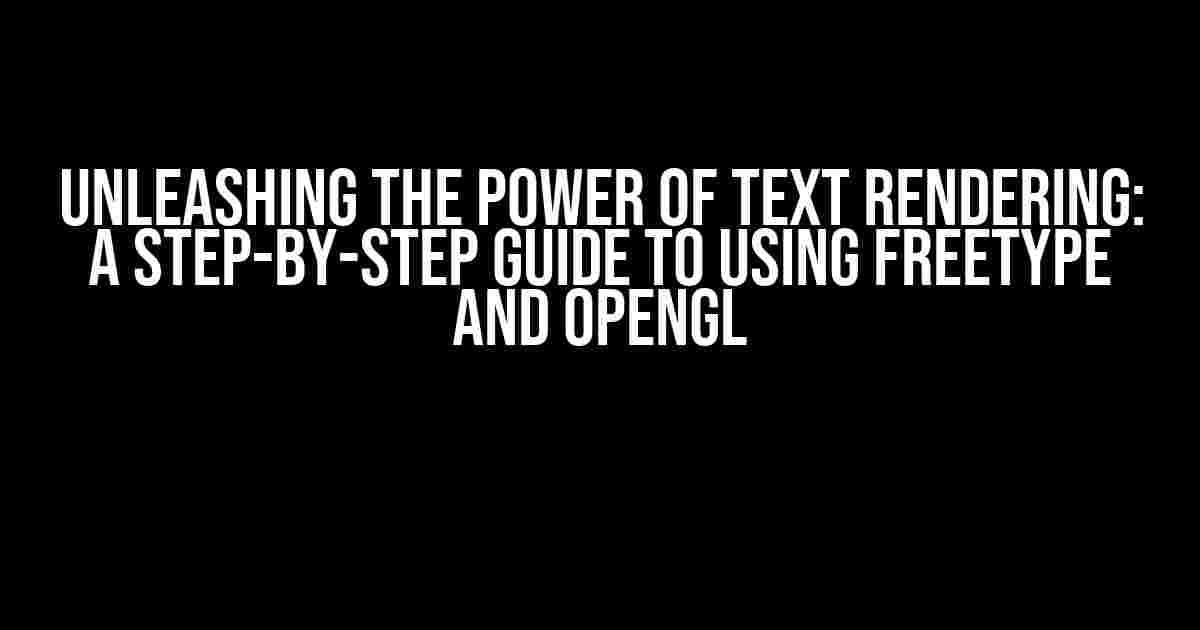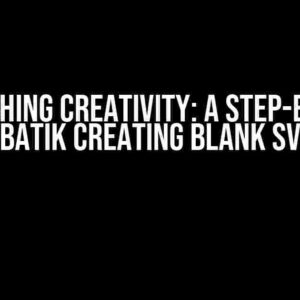Are you tired of bland, unimpressive text rendering in your graphics applications? Do you want to take your game development, scientific visualization, or graphics design to the next level? Look no further! In this comprehensive guide, we’ll show you how to harness the potent combination of FreeType and OpenGL to render stunning, high-quality text that will leave your users in awe.
- What are FreeType and OpenGL?
- Why Use FreeType and OpenGL for Text Rendering?
- Setting Up Your Development Environment
- Step 1: Initialize FreeType and Load a Font
- Step 2: Create an OpenGL Context and Render Text
- Step 3: Render Text Using FreeType and OpenGL
- Step 4: Add Some Flair with Texturing and Lighting
- The Grand Finale: Putting it All Together
What are FreeType and OpenGL?
Before we dive into the nitty-gritty of text rendering, let’s take a quick look at the two protagonists of our story:
- FreeType: A widely-used, open-source library for rasterizing vector fonts. It provides an efficient, high-quality way to render text, allowing you to tap into the vast universe of TrueType and PostScript fonts.
- OpenGL: A cross-platform, open-standard API for creating 2D and 3D graphics. With OpenGL, you can create stunning, hardware-accelerated visuals that will leave your users mesmerized.
Why Use FreeType and OpenGL for Text Rendering?
So, why should you bother with FreeType and OpenGL for text rendering? Here are just a few compelling reasons:
- High-quality text rendering: FreeType provides exquisite text rendering, with precise control over font styles, sizes, and spacing. Combine this with OpenGL’s hardware acceleration, and you’ll get silky-smooth text rendering that’s a joy to behold.
- Flexibility and customization: With FreeType and OpenGL, you can create custom fonts, manipulate font rendering, and even add crazy effects like 3D extrusions or particle systems to your text.
- Platform independence: Both FreeType and OpenGL are cross-platform, meaning you can deploy your application on Windows, macOS, Linux, and even mobile devices.
Setting Up Your Development Environment
Buckle up, folks! Before we start coding, make sure you have the following installed on your system:
- FreeType: Head over to the FreeType website (https://www.freetype.org/download.html) and grab the latest version.
- OpenGL: You’ll need an OpenGL implementation for your platform. For most systems, this will come bundled with the graphics drivers. However, if you’re using a Linux system, you might need to install the Mesa library (
libmesa).” - GLFW: We’ll use GLFW (https://www.glfw.org/download.html) to create an OpenGL context and handle windowing tasks.
- C++ compiler: Make sure you have a C++ compiler installed, such as GCC or Clang.
Step 1: Initialize FreeType and Load a Font
Now that we have our tools ready, let’s start by initializing FreeType and loading a font:
#include <freetype/freetype.h>
int main() {
// Initialize FreeType
FT_Library ft;
FT_Init_FreeType(&ft);
// Load a font (we'll use the Open Sans font for this example)
FT_Face face;
FT_New_Face(ft, "OpenSans-Regular.ttf", 0, &face);
// Set the font size to 24 points
FT_Set_Char_Size(face, 0, 24 * 64, 300, 300);
// ... (we'll get back to this later)
}
Step 2: Create an OpenGL Context and Render Text
Next, we’ll create an OpenGL context using GLFW and set up a basic rendering loop:
#include <GLFW/glfw3.h>
int main() {
// ... (FreeType initialization code)
// Initialize GLFW
glfwInit();
// Create a windowed OpenGL context
GLFWwindow* window = glfwCreateWindow(800, 600, "FreeType + OpenGL Text Rendering", NULL, NULL);
// Make the OpenGL context current
glfwMakeContextCurrent(window);
// ... (rendering loop code)
}
Step 3: Render Text Using FreeType and OpenGL
Now, the moment of truth! We’ll use FreeType to render text and OpenGL to display it:
void renderText(const char* text) {
// Create a vertex buffer object (VBO) to store the text vertices
GLuint vbo;
glGenBuffers(1, &vbo);
glBindBuffer(GL_ARRAY_BUFFER, vbo);
// Render each character in the text
for (const char* p = text; *p; p++) {
// Get the glyph for the current character
FT_UInt glyphIndex = FT_Get_Char_Index(face, *p);
FT_LOADrenderGlyph(face, glyphIndex, FT_LOAD_RENDER);
// Get the glyph metrics
FT_GlyphSlot slot = face->glyph;
FT_Bitmap& bitmap = slot->bitmap;
// Create a vertex for each pixel in the glyph
GLfloat vertices[bitmap.width * bitmap.height * 2];
for (int y = 0; y < bitmap.height; y++) {
for (int x = 0; x < bitmap.width; x++) {
vertices[(y * bitmap.width + x) * 2 + 0] = x + slot->bitmap_left;
vertices[(y * bitmap.width + x) * 2 + 1] = y + slot->bitmap_top;
}
}
// Upload the vertex data to the VBO
glBufferData(GL_ARRAY_BUFFER, sizeof(vertices), vertices, GL_STATIC_DRAW);
// Draw the text as a series of 2D triangles
glEnableVertexAttribArray(0);
glVertexAttribPointer(0, 2, GL_FLOAT, GL_FALSE, 0, 0);
glDrawArrays(GL_TRIANGLES, 0, bitmap.width * bitmap.height);
}
// Clean up
glDisableVertexAttribArray(0);
glBindBuffer(GL_ARRAY_BUFFER, 0);
glDeleteBuffers(1, &vbo);
}
Step 4: Add Some Flair with Texturing and Lighting
Let’s take our text rendering to the next level by adding some flair with texturing and lighting:
void renderText(const char* text) {
// ... (glyph rendering code)
// Create a texture for the text
GLuint texture;
glGenTextures(1, &texture);
glBindTexture(GL_TEXTURE_2D, texture);
glTexImage2D(GL_TEXTURE_2D, 0, GL_RED, bitmap.width, bitmap.height, 0, GL_RED, GL_UNSIGNED_BYTE, bitmap.buffer);
// Set up a simple lighting model
GLfloat lightPos[] = { 0.0, 0.0, 10.0, 0.0 };
GLfloat lightColor[] = { 1.0, 1.0, 1.0, 1.0 };
GLfloat materialColor[] = { 1.0, 1.0, 1.0, 1.0 };
glLightfv(GL_LIGHT0, GL_POSITION, lightPos);
glLightfv(GL_LIGHT0, GL_DIFFUSE, lightColor);
glMaterialfv(GL_FRONT, GL_DIFFUSE, materialColor);
// Render the text with lighting and texturing
glEnable(GL_TEXTURE_2D);
glEnable(GL_LIGHTING);
glDrawArrays(GL_TRIANGLES, 0, bitmap.width * bitmap.height);
glDisable(GL_LIGHTING);
glDisable(GL_TEXTURE_2D);
// Clean up
glDeleteTextures(1, &texture);
}
The Grand Finale: Putting it All Together
Now that we have all the pieces in place, let’s bring it all together:
int main() {
// Initialize FreeType and load a font
FT_Library ft;
FT_Init_FreeType(&ft);
FT_Face face;
FT_New_Face(ft, "OpenSans-Regular.ttf", 0, &face);
// Create an OpenGL context and window
GLFWwindow* window = glfwCreateWindow(800, 600, "FreeType + OpenGL Text Rendering", NULL, NULL);
glfwMakeContextCurrent(window);
// Set up the rendering loop
while (!glfwWindowShouldClose(window)) {
glClear(GL_COLOR_BUFFER_BIT | GL_DEPTH_BUFFER_BIT);
// Render some sample text
renderText("Hello, World!");
// Swap buffers and poll for events
glfwSwapBuffers(window);
glfwPollEvents();
}
// Clean up
FT_Done_Face(face);
FT_Done_FreeType(ft);
glfwTerminate();
Here are 5 Questions and Answers about "How to render text using FreeType and OpenGL":
Frequently Asked Question
Get ready to unlock the secrets of rendering text using FreeType and OpenGL! Here are some frequently asked questions to get you started:
What is FreeType and how does it relate to OpenGL?
FreeType is a popular open-source library for rendering fonts, while OpenGL is a cross-language, cross-platform API for rendering 2D and 3D graphics. To render text using FreeType and OpenGL, you'll use FreeType to load and rasterize font glyphs, and then pass those glyphs to OpenGL for rendering. Think of it as a dynamic duo for rendering text in 3D!
How do I initialize FreeType for text rendering?
To initialize FreeType, you'll need to include the FreeType headers and link against the FreeType library. Then, create a FreeType font face object using `FT_New_Face` and set the font size and style using `FT_Set_Char_Size`. Finally, use `FT_Load_Char` to load the font's glyph data. Voilà! You're ready to render text.
How do I render text using OpenGL?
To render text using OpenGL, create a vertex buffer object (VBO) to store the font glyph data. Then, use `glDrawArrays` to draw the glyphs as 2D textures. You can also use `glBindTexture` to bind the glyph texture to the VBO. Don't forget to set up a basic OpenGL context and vertex shader to handle the drawing!
How do I handle text alignment and wrapping?
To handle text alignment and wrapping, calculate the bounding box of each glyph and store the text layout information. You can use the `FT_Glyph_Metrics` struct to get the glyph's width and height. Then, use that information to position the glyphs correctly. For wrapping, iterate through the text and check if the current glyph exceeds the line width. If so, move to the next line! Simple, right?
What are some common pitfalls to watch out for when rendering text with FreeType and OpenGL?
Some common pitfalls to avoid include: incorrect font loading, glyph rendering issues, and texture sampling problems. Make sure to check for errors when loading fonts and rendering glyphs. Also, be mindful of texture filtering and sampling to avoid blurry or aliased text. With a little practice, you'll be rendering text like a pro!
I hope this helps!




